 |
||
|
||
| ||
Some times ago we considered a brand-new from STMicroelectronics/Imagination Technologies - a video card based on the KYRO chipset which belongs to the third generation of the family PowerVR. We have already talked in detail on this graphics processor and cards based on it (refer to my previous articles and our round-ups). As for their speed characteristics these cards are comparable to NVIDIA GeForce2 MX falling behind just by a small margin. The worst disadvantage of the KYRO based cards are undebugged drivers what results in artifacts in some games, and initial overprice what couldn't help to these cards to become the best competitors against GeForce2 MX (however, nowadays it has changed to the best). There are only three video card manufacturers that have released their products on the chipset. One of them is a famous Taiwanese company PowerColor which has debuted its board named EVIL KYRO. I'm happy to tell you that not so long ago the prices for similar cards have swiftly fallen down, and this card will cost approx 80USD in retail. BoardThe card has AGP2x/4x interface, 32 MBytes 6 ns SDR SDRAM located in 4 chips on the right side of the PCB: 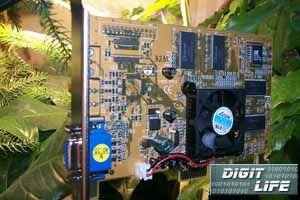 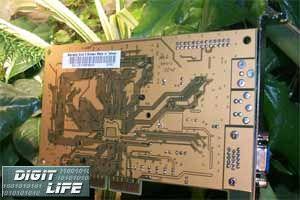 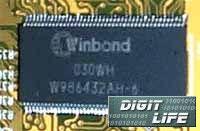 The memory chips are produced by Winbond, they are intended for 166 MHz working frequency but operate at 100 MHz as the chipset (what is less than even of the reference samples). 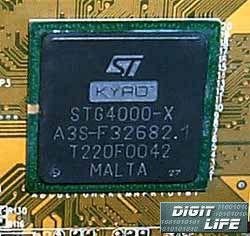 ow let's pass to specific features. The card is quite small with blank spaces for TV-out. The chipset is topped with an active cooler. Take off a cooler and you will see a graphics processor. It is quite small though it's based on 0.25 micron technology. It seems that the fact that there was used not the finest technological process and a relatively big cache inside the chipset caused the frequency to be quite low. Running ahead I should say that the chipset works at the breaking point, therefore it can hardly be overclocked. The PCB is traditionally yellow. The card is delivered in Retail-package:  What's inside the box:
OverclockingWell, as I have mentioned the chipset works as best as it can that's why with this sample of the PowerColor EVIL KYRO we managed to overclock it and get it work stable only at 113 MHz. Frequencies of the chipset and the memory are synchronized, that's why in spite of the set 166-MHz memory you won't be able to overclock it. Installation and driversThe test system is:
The video card is supplied with drivers from PowerColor, version 5.44. They are based completely on software from STMicroelectronics of the analog version. The PowerColor programmers have only added their own utility for more comfortable setting of the work in 2D-mode: 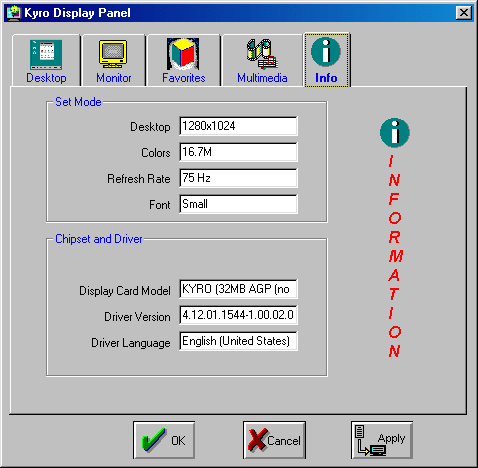 
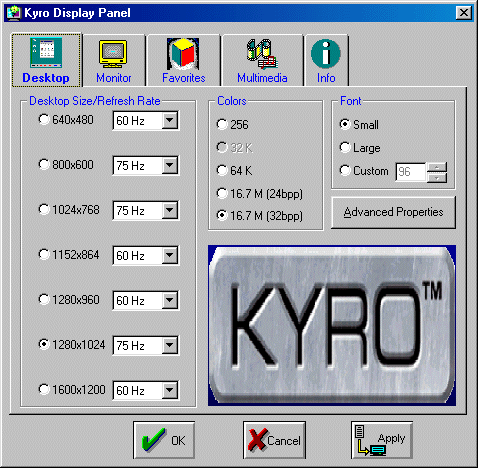 On installing the drivers in the right bottom corner you will see a pictogram that will call up the program. Note that while testing Vsync was off. Beside this card, you will see the results for the following video cards: reference card NVIDIA GeForce2 MX, reference card STMicroelectronics KYRO. Test results2D-graphics comes first. Quality of this card is not worse than that of the reference card. It means very good. 2D speed is high as well. I liked fast change of modes, clearness even at the highest resolutions. The following programs will aid in estimating performance in 3D-graphics:
Quake3 ArenaThe test on the standard demo002 was carried out in two modes: Fast (shows card's work in 16-bit color) and High Quality (shows card's work in 32-bit color). 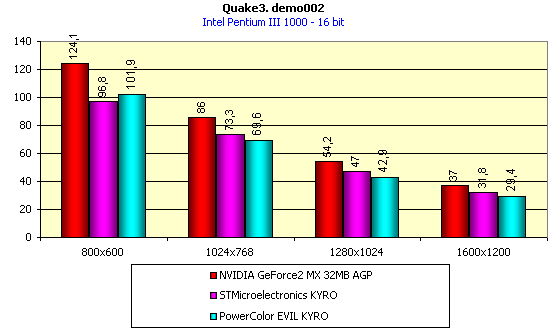 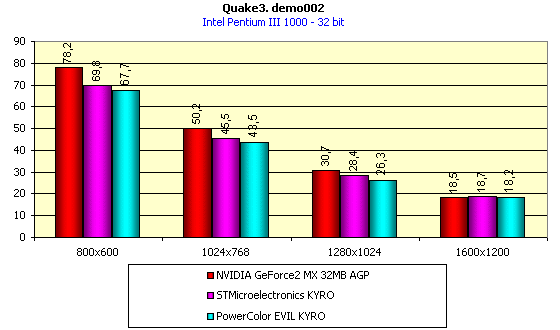 The results were expected especially considering the working frequency of the card. There is some lag from the reference card, and considering the GeForce2 MX it looks bad. The KYRO fell behind too far from their rivals even when with the reference card, and PowerColor company, by decreasing the frequency even more, only aggravated the situation. However, considering the fact that the chipset hardly overclocks it should be STMicroelectronics to blame who by release of the serial cards delivers even less speed processors than it was 3 months ago. ExpendableWe will use this game to show the card's speed in Direct3D. 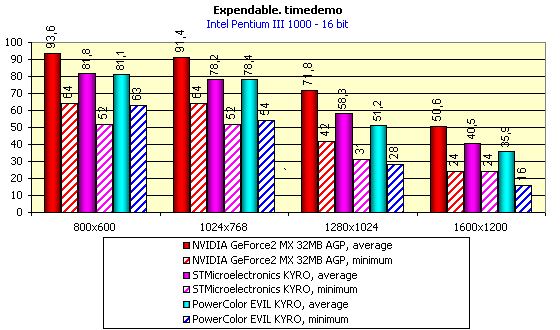 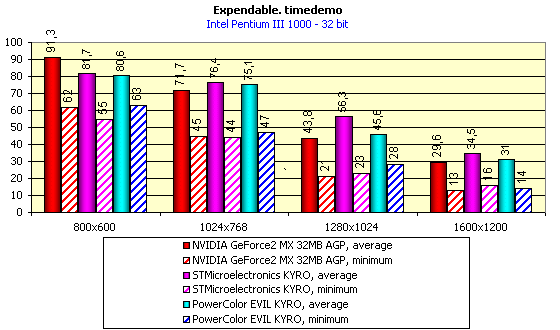 Look, Expendable in 32-bit color showed us that the KYRO is not that bad regarding the GeForce2 MX. And it is so thanks to the fact that due to architecture features, a fall when passing from 16- to 32-bit color is much less for the KYRO than for the GeForce2 MX. Why don't we see it in Quake3? It's likely a fault of the drivers and first of all ICD OpenGL. Well, in general the video card falls behind the competitor NVIDIA GeForce2 MX, and shows worse performance than the reference card from STMicroelecronics (due to lower frequency). Additional functionsUndoubtedly, many of you are interested in the work of new cards in terms of DVD-video support. The video card is equipped with a soft player WinDVD 2000. With this one the card PowerColor EVIL KYRO gave out rather decent results considering CPU utilization (29-30%), but there were still some artifacts on the images displayed. ConclusionThe company PowerColor has announced a completely new product both for users and for the company itself, it's somewhere unique considering both not wide availability and a special architecture of the KYRO. The card loses when fighting against its heaviest rival - NVIDIA GeForce2 MX in performance, but quite low price should help it to be called for: GeForce2 MX has just reached $90 and PowerColor EVIL KYRO costs much less now. But remember that KYRO-based cards lack for an integrated geometrical coprocessor (Hardware TCL). Well, I could only say that these cards will be claimed for but they will hardly become popular. Considering the architecture I must notice that a 2-pipeline processor operating at 110 MHz nearly catches up with a 4-pipeline GeForce256 SDR (you all know that the GeForce2 MX is faster than the latter). This puts forward all advantages of tile architecture. However, it wasn't much beneficial for the KYRO. The only good is the fact that the card is on the same level as GeForce2 MX card. We will not probably see mass sales but I still hope for the price policy to get better and for the manufacturers to debug the drivers. Highs:
Lows:
Write a comment below. No registration needed!
|
Platform · Video · Multimedia · Mobile · Other || About us & Privacy policy · Twitter · Facebook Copyright © Byrds Research & Publishing, Ltd., 1997–2011. All rights reserved. |